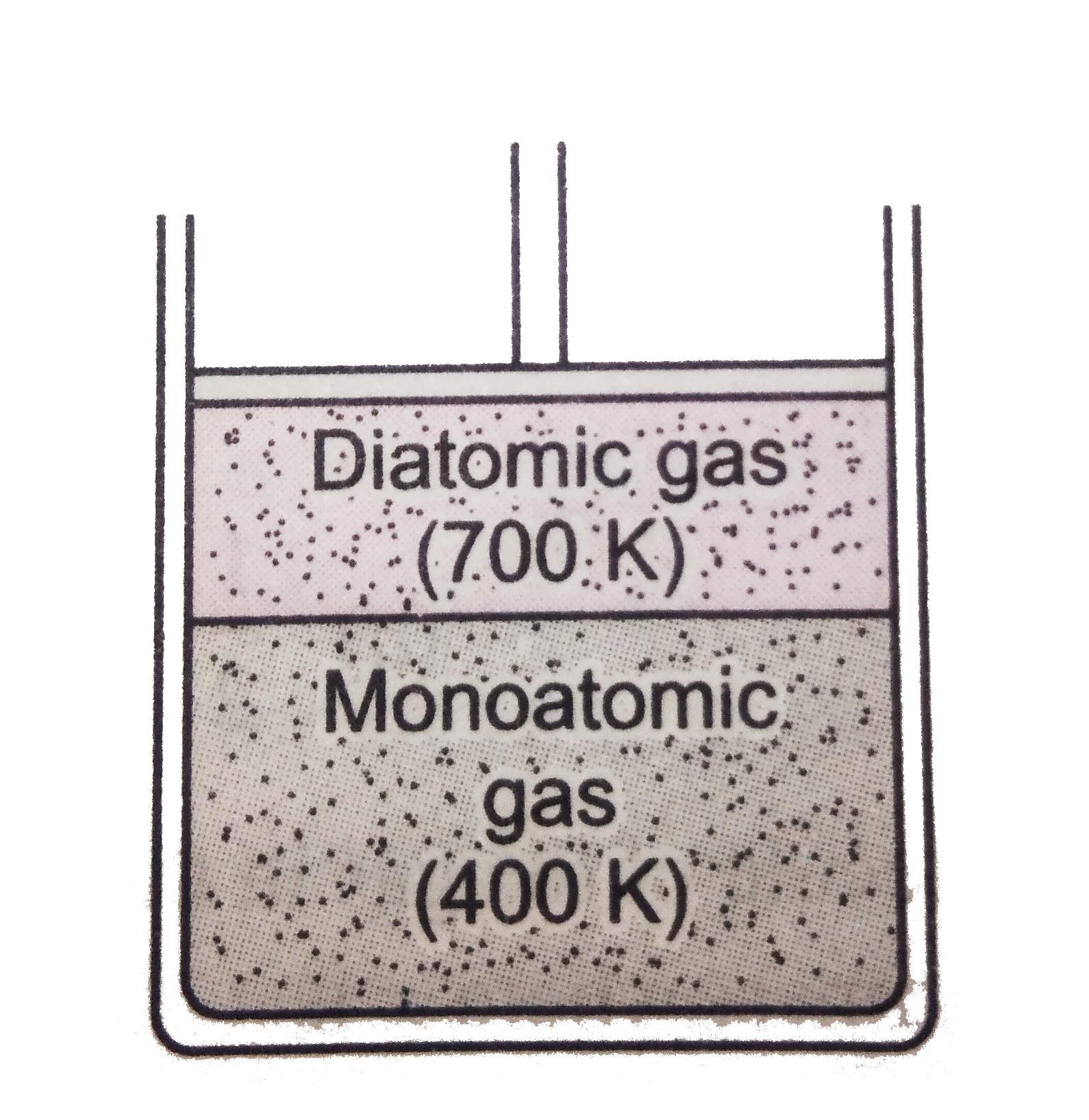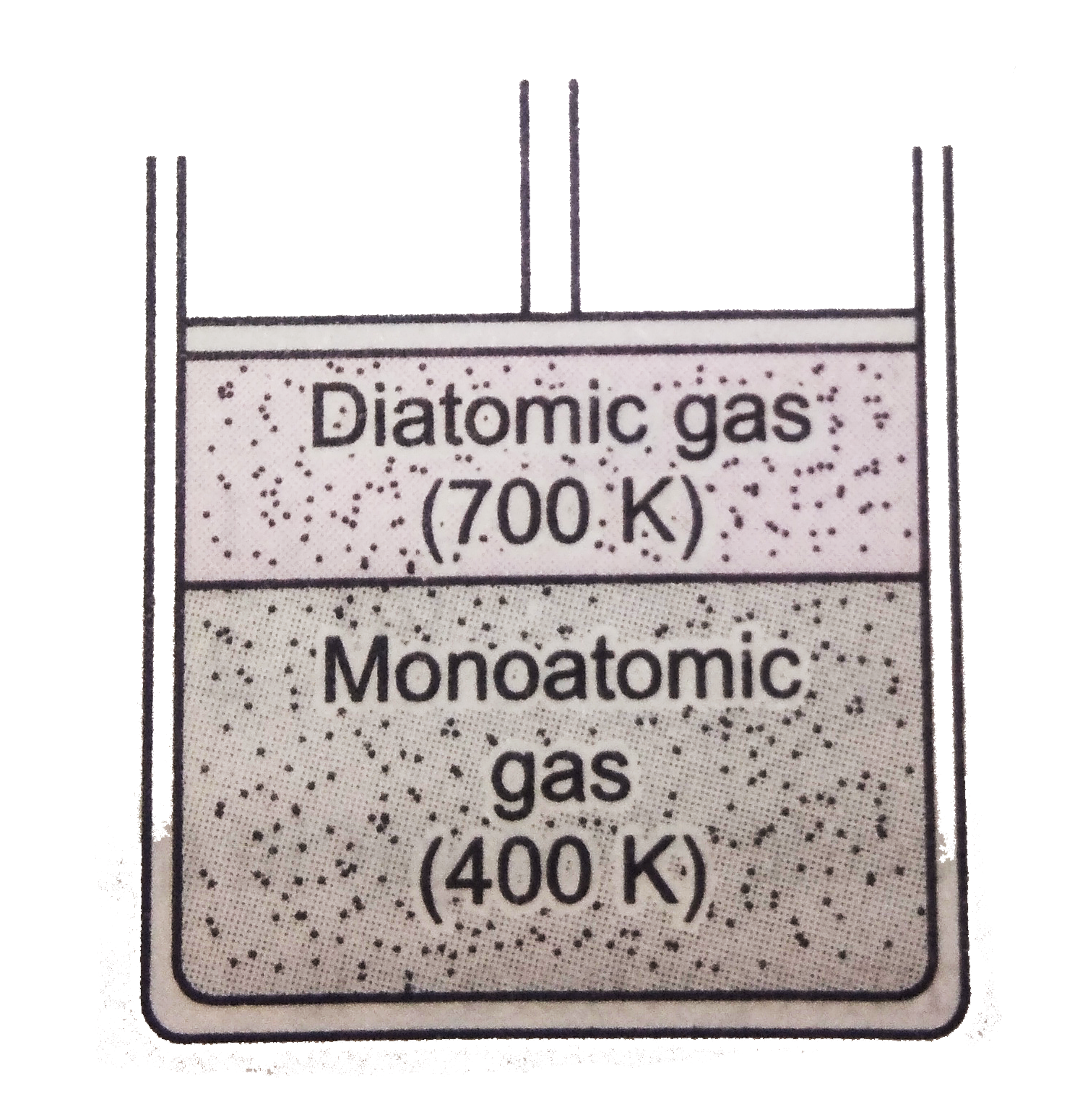A diatomic gas, having Cp=72RandCv=52R is heated at constant pressure. The ratio dU:dQ:dW
5:7:3
5:7:2
3:7:2
3:5:2
The correct Answer is:B
To find the ratio dU:dQ:dW for a diatomic gas heated at constant pressure, we can follow these steps:
Step 1: Understand the definitions
- dU is the change in internal energy.
- dQ is the heat added to the system.
- dW is the work done by the system.
Step 2: Use the formulas for each quantity
1. Change in internal energy:
dU=NCvdT
where Cv=52R for a diatomic gas.
2. Heat added at constant pressure:
dQ=NCpdT
where Cp=72R for a diatomic gas.
3. Work done at constant pressure:
dW=PdV
Using the ideal gas law, PdV=NRdT.
Step 3: Substitute the values
- For dU:
dU=N(52R)dT
- For dQ:
dQ=N(72R)dT
- For dW:
dW=NRdT
Step 4: Write the ratios
Now we can write the ratios:
dU:dQ:dW=N(52R)dT:N(72R)dT:NRdT
Step 5: Simplify the ratios
We can cancel N and dT from all terms:
52R:72R:R
This simplifies to:
52:72:1
Step 6: Multiply to eliminate fractions
To eliminate the fractions, multiply each term by 2:
5:7:2
Final Answer
Thus, the ratio dU:dQ:dW is:
5:7:2
- dU is the change in internal energy.
- dQ is the heat added to the system.
- dW is the work done by the system.
1. Change in internal energy:
dU=NCvdT
where Cv=52R for a diatomic gas.
dQ=NCpdT
where Cp=72R for a diatomic gas.
dW=PdV
Using the ideal gas law, PdV=NRdT.
- For dU:
dU=N(52R)dT
dQ=N(72R)dT
dW=NRdT
Now we can write the ratios:
dU:dQ:dW=N(52R)dT:N(72R)dT:NRdT
We can cancel N and dT from all terms:
52R:72R:R
52:72:1
To eliminate the fractions, multiply each term by 2:
5:7:2
Thus, the ratio dU:dQ:dW is:
5:7:2
Topper's Solved these Questions
- BOOK - JEE MAINS PREVIOUS YEARCHAPTER - JEE MAIN 2021EXERCISE - PHYSICS (SECTION-B)10videos
JEE MAIN 2021
- BOOK - JEE MAINS PREVIOUS YEARCHAPTER - JEE MAIN 2021EXERCISE - (SECTION - A)20videos
JEE MAIN 2021
- BOOK - JEE MAINS PREVIOUS YEARCHAPTER - JEE MAIN 2021EXERCISE - SECTION-B40videos
JEE MAIN 2021
- BOOK - JEE MAINS PREVIOUS YEARCHAPTER - JEE MAINEXERCISE - All Questions473videos
JEE MAIN
- BOOK - JEE MAINS PREVIOUS YEARCHAPTER - JEE MAIN 2022EXERCISE - Question492videos
JEE MAIN 2022
Similar Questions
Heat is supplied to a diatomic gas at constant pressure.
The ratio of ΔQ:ΔU:ΔW isView SolutionIn Fig., a container is shown to have a movable (without friction) piston on top. The container and the piston are all made of perfectly insulating material allowing no heat transfer between outside and inside the container. The container is divided into two compartments by a rigid partition made of a thermally conducting material that allows slow transfer of heat. the lower compartment of the container is filled with 2 moles of an ideal monoatomic gas at 700 K and the upper compartment is filled with 2 moles of an ideal diatomic gas at 400 K. the heat capacities per mole of an ideal monoatomic gas are Cυ=32RandCP=52R, and those for an ideal diatomic gas are Cυe=52RandCP=72R.
Now consider the partition to be free to move without friction so that the pressure of gases in both compartments is the same. the total work done by the gases till the time they achieve equilibrium will be
 View Solution
View Solution
Knowledge Check
- Question 1 - Select One
Specific heat at constant pressure CP of a gas
Amore than the specific heat at constant volume (CV)Bless then the specific heat at constant volume (CV)Cequal to the specific heat at constant volume (CV)Dmay be more or less than specific heat at constant volume (CV) - Question 2 - Select One
In Fig., a container is shown to have a movable (without friction) piston on top. The container and the piston are all made of perfectly insulating material allowing no heat transfer between outside and inside the container. The container is divided into two compartments by a rigid partition made of a thermally conducting material that allows slow transfer of heat. the lower compartment of the container is filled with 2 moles of an ideal monoatomic gas at 700 K and the upper compartment is filled with 2 moles of an ideal diatomic gas at 400 K. the heat capacities per mole of an ideal monoatomic gas are Cυ=32RandCP=52R, and those for an ideal diatomic gas are Cυe=52RandCP=72R.
Consider the partition to be rigidly fixed so that it does not move. when equilibrium is achieved, the final temperature of the gases will be
 A550 KB525 KC512.5 KD490 K
A550 KB525 KC512.5 KD490 K - Question 3 - Select One or More
If one mole of an ideal gas with Cv=32R is heated at a constant pressure of 1 atm 25∘C to 100∘C. Which is correct
AΔU during the process is 223.51 calBΔH during the process is 372.56 calCentropy change during the process is 1.122calk−1mol−1DΔU,ΔH are same for the process
When two mole of an ideal gas (Cp.m=52R) heated from 300K to 600K at constant pressure. The change in entropy of gas (ΔS) is:
View SolutionMolar heat capacity of an ideal gas in the process PVx = constant , is given by : C=Rγ−1+R1−x. An ideal diatomic gas with CV=5R2 occupies a volume V1 at a pressure P1. The gas undergoes a process in which the pressure is proportional to the volume. At the end of the process the rms speed of the gas molecules has doubled from its initial value.
Heat supplied to the gas in the given process is :View SolutionMolar heat capacity of an ideal gas in the process PVx = constant , is given by : C=Rγ−1+R1−x. An ideal diatomic gas with CV=5R2 occupies a volume V1 at a pressure P1. The gas undergoes a process in which the pressure is proportional to the volume. At the end of the process the rms speed of the gas molecules has doubled from its initial value.
The molar heat capacity of the gas in the given process is :-View SolutionAn ideal diatomic gas with CV=5R2 occupies a volume V1 at a pressure P1. The gas undergoes a process in which the pressure is proportional to the volume. At the end of the process the rms speed of the gas molecules has doubled from its initial value.
Heat supplied to the gas in the given process isView SolutionAn ideal diatomic gas with CV=5R2 occupies a volume V1 at a pressure P1. The gas undergoes a process in which the pressure is proportional to the volume. At the end of the process the rms speed of the gas molecules has doubled from its initial value.
The molar heat capacity of the gas in the given process isView Solution

